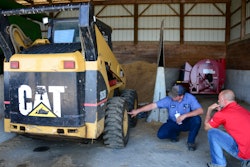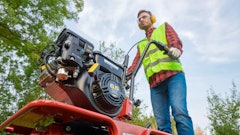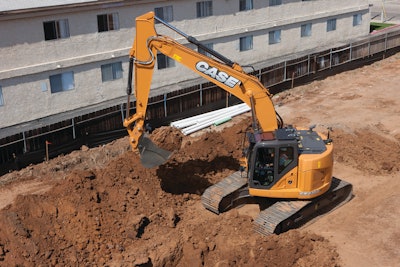
The operator plays a critical role in minimizing construction equipment owning and operating costs. Ted Polzer, director of product and customer support, Case Construction Equipment and Brad Stemper, director of light equipment, Case Construction Equipment explain how operator inspections can catch potential issues before they become problems, resulting in increased up time and machine efficiency.
The operator is in the best position to monitor machine health. “He is going to notice the little changes in that machine over time,” notes Stemper. The operator can note daily changes, such as if something got damaged yesterday during operation. “Maybe your tracks or tires have a new cut. Maybe there is an oil point that is gathering dust and dirt.” By developing an inspection routine, the operator’s observations provide critical insight.
Let’s take a look at some of the key inspection points.
Daily Service Checks
Daily service checks are heavily dependent on the type of machine being utilized. Operators need to become familiar with the particular machine they use and develop a routine.
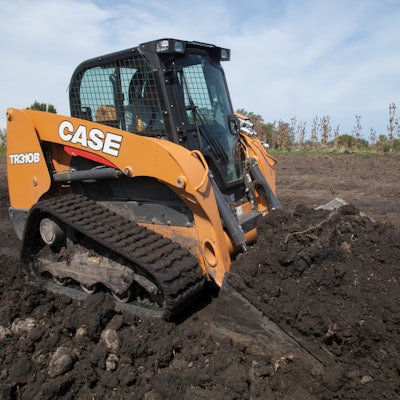 Rubber tires and tracks can easily be damaged during a shift. With compact track loaders, it is important to look for cracks, damage and debris. Also look at rollers and idlers.Case Construction Equipment
Rubber tires and tracks can easily be damaged during a shift. With compact track loaders, it is important to look for cracks, damage and debris. Also look at rollers and idlers.Case Construction Equipment
“You want to keep that radiator cool and any material that blocks airflow, it’s definitely going to make that machine run hot. You want to be observant of material or debris that might be collecting during your operation day,” notes Stemper. “Is it clogging the radiator? There are certain machines that have chaff screens that you want to check.” These make it a little easier to clean out the coolers.
Keep an eye on fluid levels. “You are going to be looking at fluid levels, such as hydraulics or coolant fluid level,” says Stemper. Make sure you understand where all of the fluid level checks are located on the particular machine being utilized.
In addition, you need to check filters. “If you do your own maintenance, one of the tips and tricks that I always recommend is mark the date, time and hours that you actually perform that last filter change so that you know what the life on them is,” says Polzer. This is important beyond simply tracking hours. “Let’s say you had some dirty fuel that was delivered and may have gotten into a few different machines. At least you know that last time that filter was changed.” It helps you identify the root cause of the problem. You are also not blindly changing fuel filters that don’t need to be replaced.
Air and fluid filters are not the only concern. “One of the most common areas that’s actually overlooked are cab filters,” says Polzer. “Engine filters are always the first thing that customers think of and normally those are addressed pretty frequently.” If it is a hot day and your AC isn’t performing like it normally does, check to make sure the cab filter is not packed full of debris. While you can blow out the filter to get by, it really isn’t a substitute for replacing the filter with a clean one.
Belts are often out of sight due to protective guards. “It is important to periodically glance [around the guard] to make sure there isn’t debris around the belt. Make sure you don’t have any guards contact with the belt that can cause premature wear,” says Polzer. “Then also inspect the belt itself.” Check for cracks that indicate you need to change the belt. “It is cheap insurance to have a spare belt with you on your truck.”
Inspect Tracks and Tires
Rubber tires and tracks can easily be damaged during a shift. With compact track loaders, it is important to look for cracks, damage and debris. “Maybe you have hit something sharp that has stuck through the tread,” says Polzer. “In addition to just the rubber tire and tracks, we also want to be taking a look at rollers and idlers." But he cautions, "Unless it has an obvious oil leak that is easy to spot, an idler or roller sometimes can be very, very hot, so we recommend that customers don’t actually touch these components after the machine has been running because it can burn you. They’re extremely hot.”
This is where an affordable temperature gun that is readily available can prove useful. This allows you to identify hot spots. Some of these devices provide thermal imaging. “We can clearly point out a roller that is extremely hot that needs attention,” notes Polzer.
Tires present their own unique set of challenges. “Tire pressure is extremely important with your machines and under-inflated tires can create excessive heat that can lead to shorter life,” explains Polzer. It can prematurely wear the tire tread. “It is extremely important to monitor that every day that you get started. You can either do that through the use of an air pressure gauge or you can do a visual on them if you know they’ve been set properly to that jobsite when you first got started.”
Maintain Grease Points
Grease provides the protection necessary to prevent excessive wear and failure between moving components. Up time is dependent upon grease getting to the proper location and in the proper amount.
“The first thing that any operator should do is open up the operator’s manual and familiarize themselves with the grease points and the frequency for those,” says Stemper. “Some grease points are daily, some grease points are not as frequent.” The amount of grease is also important. “It’s not simply connecting that grease gun to that point. It’s the appropriate number of grease fill pumps. Not all grease points require you to pump until something comes out of that grease spot. That’s not always the appropriate thing to do.
Check documentation to make sure critical joints are not missed. “There are often diagrams on the machine, definitely inside the operator’s manual with the grease points and how much those grease points take,” notes Stemper.
Make sure not to miss less visible grease points. “Operators can sometimes bypass certain points that might be higher up on the machine if there are not remote grease zerks,” says Stemper.
In joints such as bucket pins that are often operated underground or in wet or underwater conditions, grease helps purge the contaminants and provides a new fluid film for rotating components. “Making sure you are greasing those areas is going to make the machine more efficient.” Greasing these areas also provides a good opportunity to check these highly vulnerable areas of the machine for damage such as bulging hoses, and dinged or nicked cylinders.
Identify Leaks
By their nature, construction machines often work in dirty environments that can make it more of a challenge to identify leaks. “In the morning as the machine has been sitting, oftentimes gravity is going to be our friend and if you have a leak we’re going to start to see that along rollers and seals,” notes Polzer. “But primarily one of the things we really try to monitor and pay attention to is looking for accumulations of dirt in certain areas. Any time we have a fitting that is leaking, we start to get oil residue and oil residue attracts dirt, especially in dusty environments.”
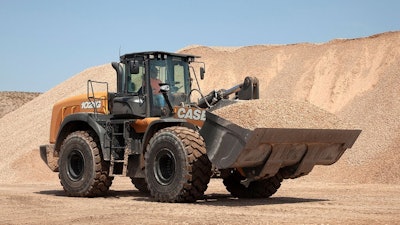 Tire pressure is extremely important. Under-inflated tires can create excessive heat that can lead to shorter life.Case Construction Equipment
Tire pressure is extremely important. Under-inflated tires can create excessive heat that can lead to shorter life.Case Construction Equipment
A lot of newer machines come with UV reactive dye in the oil. An inexpensive UV flashlight can make the oil glow, which makes leaks, even in very hard to access areas, easy to find. “If it’s a machine that you don’t know if it has UV reactive dye, that can be added to the oil,” notes Polzer. “It is relatively inexpensive.”
Auxiliary hydraulics are another area that require operator diligence. “If you are operating auxiliary hydraulics, it is an absolutely vital spot to pay attention to,” says Stemper “The best thing to do if you are changing attachments is to carry a rag with you. Leave it in the machine. Make sure it’s a clean rag, the worst thing to do is clean something with a dirty rag. Before you connect those [hydraulic couplings] you want to make sure those parts are clean. You don’t want to introduce any dirt on the hydraulic hose connection or on the machine connection by shoving it in without cleaning it. So, make sure those ports are clean.”
There are steps you can take to keep attachment connections clean. “When you disconnect the hydraulic hoses on an attachment, don’t hesitate to connect the two halves together,” says Stemper. “That creates a circuit that allows the entire attachment to be protected. It keeps fittings out of the dirt so you have less dirt to clean up. It also allows the pressure to equalize in both lines.”
Monitor Cutting Edges
Teeth and cutting edges provide the ability for a machine to complete the task efficiently. Using teeth and cutting edges that are worn down will result in a loss of fuel efficiency. If the machine is working inefficiently, there is also likely more heat buildup.
“It is important to observe how your teeth are wearing,” says Stemper. “Do you have the right teeth on your machine for the application? Some teeth are better designed for harder materials, some are better designed for softer materials. It’s really important to investigate whether you are using the right teeth and the right cutting edge for your application. In the end, putting the right tooth on and using it within its normal useful life range gives you that efficiency in operation. You’re going to be more productive in filling the bucket, filling the material, loading the material into a truck by having those newer teeth or sharper edges.”
The Start Up
After the operator inspects the machine in the morning, it is good to develop a startup procedure. “It is a good practice to be able to start a machine and let it warm up a little bit by simply idling,” says Polzer. “Obviously, idling too long is a bad thing. What I like to do is start the machine up and let the machine go through all of its self checks. As it’s warming up, I like to validate my lights are working. Then as that machine has been warming up I like to look back at the display and make sure we don’t have any warnings on the dash.”
Communication is vital. “If you have multiple shifts that are operating, make sure that you have a process for each shift to be able to communicate if there’s anything that has been noticed or going on with that unit,” adds. Polzer. “Maybe there was an intermittent fault code that had popped up last night, but because it wasn’t on when the operator shut it off, he didn’t alert anybody. That could be really important because that might be leading up to a bigger downtime scenario."







